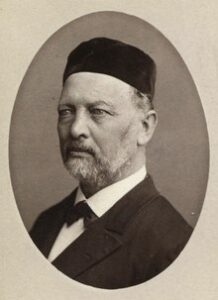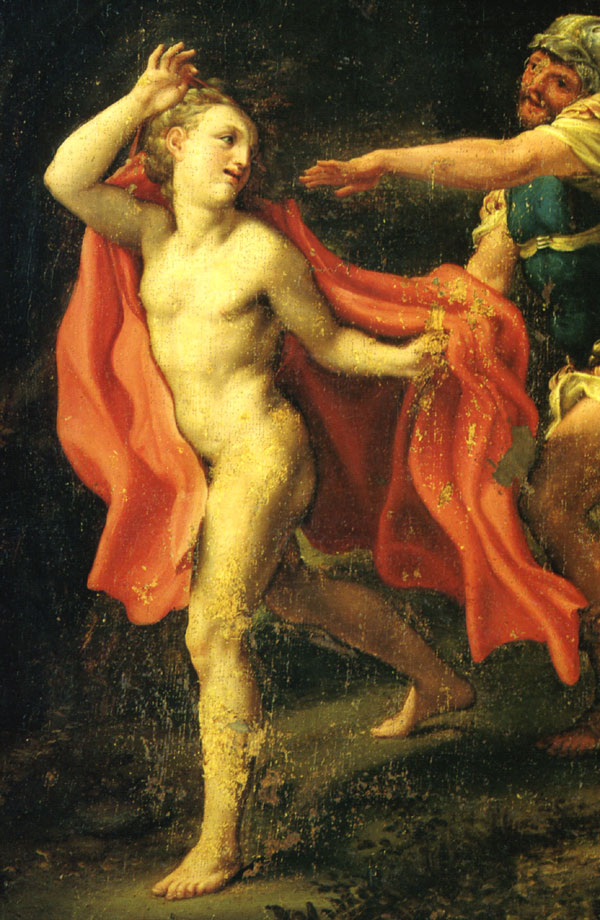In the previous post I tried to explain my startled response when, many years ago, I first read the Gospel of Mark in a translation that muffled familiar associations with the other gospels. I recall being left with a feeling of some horror, of a Jesus who was certainly not a human-loveable Lukan figure welcoming home a prodigal son, nor a Johannine “good shepherd” nor a Matthean Jesus who promised to be with his disciples at all times.
* p. 2. Also: Hellenistic Jews and early Christians also engage with the tragedy in various and interesting ways (p.2) . . . . Dionysiac mysteries became particularly popular during the Hellenistic and Roman periods (p.31) . . . . Among ancient poets, Euripides’ popularity in antiquity was second only to that of Homer. (p.41) . . . . performances of his plays became widely accessible, including, as we shall see, to both Jews and Christians (p. 42) . . . . In addition to Euripides’ general status in antiquity, the Bacchae’s popularity in particular is also well attested. (p. 45) . . . . Given the pervasive influence and popularity of tragedy in the Greco-Roman world it is likely that the Gospel’s author knew Greek tragedy. (p. 216) — (Friesen)
** Bilby, MacDonald, Moles, Wick (see bibliography below)
My impression as an outsider reading much of the relevant scholarly literature is that most scholars seem to accept that Jesus in the Gospel of Mark is the “most human” Jesus when compared with his portrayal in the other gospels. But the more I read of Greco-Roman literature that is known to have been the literary matrix from which the gospels were composed, the harder it is for me to accept Mark’s Jesus as even the least bit genuinely “human”. The Jesus in the Gospel of Mark comes across to me very much the way a certain Greek god is depicted in literature “widely popular throughout antiquity”*.
Now I do not want to say that the author of the gospel was intentionally step-by-step modeling Jesus on Dionysus. I mean no more than that he appears to have deemed appropriate for his Jesus various Dionysian tropes that were no doubt familiar in the “wider cultural air”. Others** have written about Dionysian themes in the Gospel of John and the Acts of the Apostles. But in the light of my previous post, consider:
- I concluded earlier that the Gospel of Mark’s Jesus is a “terrifying figure” but I should have added that he is also a deliverer from suffering. He heals people of their diseases and their demonic torments. Dionysus is likewise a terrifying figure, one who leaves his enemies mystified and fearful over his mysterious origin and fearful powers. But he is also a comforter of those who suffer:
“For he is great in many ways, but above all it was he,
or so they say, who gave to mortal men
the gift of lovely wine by which our suffering
is stopped. And if there is no god of wine,
there is no love, no Aphrodite either,
nor other pleasure left to men.”
and
“Dionysus, son of Zeus, consummate god,
most terrible, and yet most gentle, to humankind.”
finally,
“filled with juice from vines,
suffering mankind forgets its grief; from it
comes sleep; with it oblivion of the troubles
of the day. There is no other medicine
for misery. And when we pour libations
to the gods, we pour the god of wine himself
that through his intercession man may win
the good things of life.”
- Jesus comes as a man, a “son of man”, as does Dionysus:
“And here I stand, a god incognito,
disguised as man, beside the stream of Dirce
and the waters of Ismenus”
and having emptied himself of divinity ….
“To these ends I have laid divinity aside
and go disguised as man.”
- Mark’s Jesus speaks in parables and in his last days he confounds his critics who try to trap him in his words. The god Dionysus speaks in riddles and confounds his enemies with wit. Thus :
“Your answers are designed to make me curious.” . . . “You shall regret these clever answers. . . . You wrestle well—when it comes to words” . . . “The things you say are always strange.” (Pentheus, the enemy of Dionysus, speaking to the god disguised as a man)
“The others are all blind. Only we can see.” (Tieresias, a physically blind follower of Dionysus)
On another occasion the blind prophet Tieresias explains the “true meaning” of a popular myth:
“You sneer, do you, at that story
that Dionysus was sewn into the thigh of Zeus?
Let me teach you what that really means . . . . ”
- Jesus is the miracle worker above all else. So is Dionysus:
“Sir, this stranger who has come to Thebes is full
of many miracles. ”
and
“We cowherds and shepherds
gathered together, wondering and arguing
among ourselves at these fantastic things,
the awesome miracles those women [followers of Dionysus] did.”
and
“I am also told a foreigner [sc. Dionysus] has come to Thebes
from Lydia, one of those charlatan magicians”
and
“I wanted to report
to you and Thebes what strange fantastic things,
what miracles and more than miracles,
these women [worshipers of Dionysus] do.”
- Jesus was mocked and humiliated. As was Dionysus. (I know of no classicist who applies the “criterion of embarrassment” to the story of Dionysus to claim that D’s story could not have been “made up” — “who would make up a story about a humiliated god?” — but must have a “historical core”.)
“For I have come
to refute that slander spoken by my mother’s sisters—
those who least had right to slander her.
They said that Dionysus was no son of Zeus,
but Semele had slept beside a man in love
and foisted off her shame on Zeus—a fraud, they sneered,
contrived by Cadmus to protect his daughter’s name.
They said she lied,”
and
“I tell you,
this god whom you ridicule shall someday have
enormous power and prestige throughout Hellas”
and
“We captured the quarry [sc. Dionysus] you sent us out to catch.
Our prey here was quite tame: refused to run,
but just held out his hands as willing as you please”
and once captured, the enemy of Dionysus announces a series of humiliating treatments, beginning with…
PENTHEUS First of all,
I shall cut off your girlish curls.DIONYSUS My hair is holy.
My curls belong to god.(Pentheus shears away some of the god’s curls.)”
- One reason scholars claim Jesus in the Gospel of Mark is “more human than divine” is his loss of temper when confronting the hard-hearted Pharisees. Of Dionysus it is also complained that
“CADMUS Gods should be exempt from human passions.”
Those who know their Euripides will recognize the irony in this line. See https://vridar.org/2015/07/10/understanding-the-emotional-jesus-temple-tantrums-name-calling-and-grieving/ (also https://vridar.org/2020/08/04/jesus-the-logos-in-roman-stoic-philosophers-eyes/ and https://vridar.org/2019/05/04/once-more-we-rub-our-eyes-the-gospel-of-marks-jesus-is-no-human-character/ )
-
- Another aspect used to assert the humanity, even human sinfulness, of Jesus, is the Gospel of Mark’s straightforward introduction depicting Jesus going to John to undergo a “baptism of repentance”.
No-one should respond to this point until they have read:
As Dionysus enters into his own mysteries as a neophyte Dionysiac, so Jesus identifies with those who enter his cult through baptism. As all who follow him must take up his cross, so all who are baptized will enter into baptism with him…. But that’s another post for a later time.
My point here is that Jesus in the Gospel of Mark can, with ease, be slotted into a template that was pioneered by another god who came to the Greek world from “Asia”. It may not be irrelevant to further note that even the Jewish god Yahweh has been identified with Dionysus:
- Amzallag, Nissim. “Were YHWH and Dionysus Once the Same God?” The Ancient Near East Today: Current News About the Ancient Past, August 2017. http://asorblog.org/2017/08/15/yhwh-dionysus-god/.
- Escarmant, Christine. “Dionysos dieu des Juifs : la mesure du mélange,” n.d. http://perso.wanadoo.fr/marincazaou/rabelais/dionyses.html.
–0–
I have only scratched the surface of the questions arising here. Dionysus come to bring about the fall of the royal house of Thebes as Jesus might be said to presage the fall of Jerusalem and its Temple. Dionysus introduces horror — the divine power leaves his enemies confused and terrified. But one step at a time.
All of the above arose in my mind as I contemplated the question of the origins of Christianity itself. It is so easy to think that the gospel narrative originated with a miracle-working teacher who attracted followers, came to be very highly esteemed, so much so that after his death he was believed to have risen to heaven and to have been the messiah. That might make some sense if the Gospel of Luke was the earliest narrative evidence we have for Jesus. But unfortunately Luke’s gospel is not witnessed by any source until the latter half of the second century. Most scholars have concluded that the Gospel of Mark is the earliest narrative about Jesus. If so, and if the original reading of Mark that makes Jesus a fearful divinity is valid, then it’s back to the drawing board to try to figure out Christian origins. The above concept of the worship of Jesus (or Dionysus) can only make sense if there was already in existence a cult of Jesus (or Dionysus). It cannot explain the origin of that cult.
Friesen, Courtney J. P. Reading Dionysus: Euripides’ Bacchae and the Cultural Contestations of Greeks, Jews, Romans, and Christians. Tü̈bingen: Mohr Siebeck, 2015.
Other:
- Bilby, Mark G. “The First Dionysian Gospel:: Imitational and Redactional Layers in Luke and John.” In Classical Greek Models of the Gospels and Acts, edited by Mark G. Bilby, Michael Kochenash, and Margaret Froelich, 3:49–68. Studies in Mimesis Criticism. Claremont Press, 2018.
- MacDonald, Dennis. The Dionysian Gospel: The Fourth Gospel and Euripides. Minneapolis, MN: Fortress Press, 2017. https://www.scribd.com/book/344902292/The-Dionysian-Gospel-The-Fourth-Gospel-and-Euripides.
- Moles, John. “Jesus and Dionysus in ‘The Acts Of The Apostles’ and Early Christianity.” Hermathena, no. 180 (2006): 65–104.
- Wick, Peter. “Jesus Gegen Dionysos? Ein Beitrag Zur Kontextualisierung Des Johannesevangeliums.” Biblica 85 (2004): 179–98.
All quotes from Euripides’ Bacchae are from:
- Griffith, Mark, Glenn W. Most, David Grene, and Richmond Lattimore, eds. “The Bacchae.” In Greek Tragedies 3: Aeschylus: The Eumenides; Sophocles: Philoctetes, Oedipus at Colonus; Euripides: The Bacchae, Alcestis, Third edition., 278–374. Chicago ; London: University of Chicago Press, 2013.




